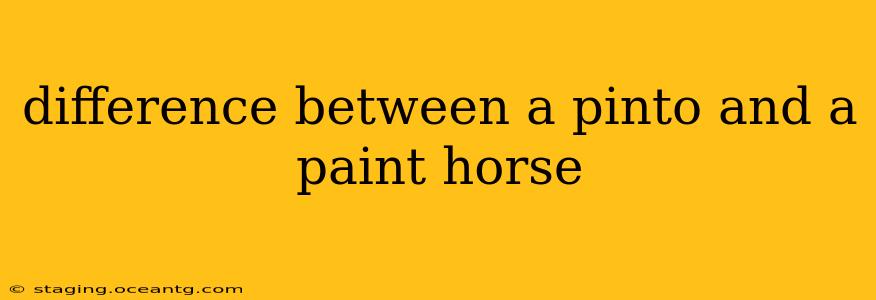The terms "pinto" and "Paint" are often used interchangeably, leading to confusion about the distinction between these beautiful spotted equines. While they share a similar characteristic—a coat of two or more colors—there's a crucial difference that sets them apart. Understanding this difference involves delving into breed registration and genetic heritage.
What is a Pinto Horse?
A pinto is simply a horse with a coat of two or more colors. The term "pinto" is a descriptive term, not a breed registration. This means any horse with a specific color pattern—regardless of its breed—can be called a pinto. Think of it as a general term for a horse with a piebald or skewbald coat.
- Piebald: A predominantly white coat with patches of another color, usually black.
- Skewbald: A predominantly white coat with patches of any color other than black.
This broad definition allows for a vast array of horse breeds to fall under the pinto umbrella. You could have a pinto Quarter Horse, a pinto Mustang, or a pinto Thoroughbred, just to name a few. The pinto designation focuses solely on the color pattern, not the horse's lineage or other breed characteristics.
What is a Paint Horse?
A Paint Horse, on the other hand, is a specific breed registered with the American Paint Horse Association (APHA). To be registered as a Paint Horse, a horse must meet specific criteria related to its lineage and coat pattern. While the coat pattern is a key element, it's not the sole defining factor.
The APHA defines a Paint horse based on its ancestry and the presence of a specific amount of white in its coat. Essentially, they have a documented pedigree tracing back to established Paint bloodlines, and their markings must meet the association's standards. The coat pattern is indeed significant, but breed lineage is paramount.
What is the difference? A Summary
The core difference is breed registration vs. coat description.
- Pinto: A descriptive term for any horse with a two-toned coat (piebald or skewbald). No breed registry is involved.
- Paint: A specific breed registered with the APHA, requiring a documented lineage and specific coat pattern to qualify.
Frequently Asked Questions
Q: Can a Paint Horse be a Pinto?
A: Yes! All Paint Horses are pintos because they have the characteristic two-toned coat. However, not all pintos are Paint Horses.
Q: How are Paint Horse coat patterns categorized?
A: APHA recognizes a variety of coat patterns including tobiano, overo, and tovero. These patterns describe the distribution of white and colored markings across the horse's body.
Q: Are there other breed registries for painted horses?
A: Yes, there are other registries, like the National Paint Horse Association (NPHA), although the APHA is the most widely recognized. These registries may have slightly different requirements for registration.
Q: What are the main differences in temperament or conformation between Paint Horses and other breeds that are also pintos?
A: There's no inherent difference in temperament or conformation simply based on the pinto marking. The temperament and physical characteristics of a horse will depend more on its breed and individual genetics. A Paint Horse will inherit the general characteristics associated with its breed, while other pinto horses will reflect their respective breed's traits.
By understanding these key distinctions, you can better appreciate the rich diversity within the equine world and accurately describe these strikingly beautiful spotted horses.
